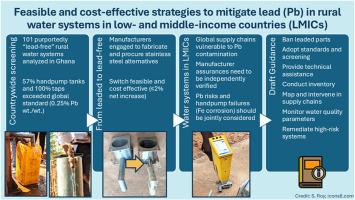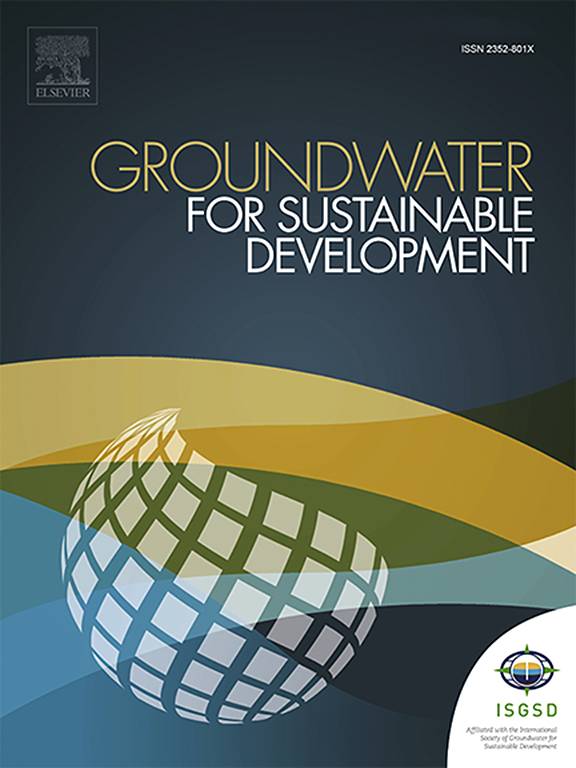通过分析筛选、政策和标准执行以及供应链干预措施,预防中低收入国家农村社区水系统中的铅污染
IF 4.9
Q2 ENGINEERING, ENVIRONMENTAL
引用次数: 0
摘要
铅(Pb)是一种神经毒性金属,可以从管道部件浸出到饮用水中。本研究调查了加纳农村社区供水系统中的铅污染,为中低收入国家减少铅污染的战略提供信息。我们使用手持式x射线荧光(XRF)分析仪筛选了101个系统,包括83个井眼手动泵和17个机械化管道系统,这些系统在2019-22年期间安装在七个地区。尽管制造商保证组件是无铅的,但57%的井眼手动泵储罐和100%的机械化系统水龙头都超过了国际“无铅”标准0.25%的铅w/w。其他部件,如立管、杆、气缸和底阀,一般符合标准。不同地区、不同安装年限系统的铅含量无显著差异(p > 0.05)。因此,我们聘请原始设备制造商(oem)来采购真正的无铅替代品。一家制造商的不锈钢水龙头取代了含铅黄铜水龙头,另一家制造商定制了不锈钢手动泵水箱和喷嘴,以取代含铅的镀锌钢部件。在安装前,通过XRF验证这些材料无铅。尽管多家原始设备制造商最初声称,采购无铅组件将非常困难或昂贵,但这种转换在物流上是可行的,并且只增加了2%或更少的总安装成本。我们的研究结果突出了全球管道供应链和制造实践中的漏洞,这些漏洞可能会引入铅并伤害消费者,并说明了独立验证OEM保证和无铅组件规格的价值。我们为执行者提供指导,以减轻水中的铅污染,并采取一些措施,也限制了与铁腐蚀有关的系统故障。这包括遵守产品质量标准、分析筛选考虑、供应链干预、水质监测和现有系统的逐步补救。本案例研究表明,在加纳和其他低收入和中等收入国家,从农村供水系统中消除铅是可行且具有成本效益的。本文章由计算机程序翻译,如有差异,请以英文原文为准。

Preventing lead (Pb) contamination in rural community water systems in LMICs through analytical screening, policy and standards enforcement, and supply chain interventions
Lead (Pb) is a neurotoxic metal that can leach into potable water from plumbing components. This study investigated Pb contamination in rural community water systems in Ghana to inform strategies for reducing its occurrence in low- and middle-income countries (LMICs). We screened 101 systems, including 83 borehole handpumps and 17 mechanized piped systems, installed across seven districts during 2019–22, using a handheld X-Ray Fluorescence (XRF) analyzer. Despite manufacturer assurances that components were lead-free, 57 % of tanks in borehole handpumps and 100 % of taps in mechanized systems exceeded the international “lead-free” standard of 0.25 % Pb w/w. Other components like riser pipes, rods, cylinders, and foot valves generally met standards. There were no significant differences in Pb content (p > 0.05) for systems across districts or installation years. Consequently, we engaged original equipment manufacturers (OEMs) to source truly lead-free alternatives. Stainless steel taps from one manufacturer replaced leaded brass taps, and a second manufacturer custom-fabricated stainless steel handpump tanks and spouts to replace lead-containing galvanized steel components. These were verified lead-free via XRF before installation. Despite initial claims from multiple OEMs that sourcing lead-free components would be prohibitively difficult or expensive, the switch was logistically feasible and increased overall installation costs by only 2 % or less. Our findings highlight vulnerabilities in global plumbing supply chains and manufacturing practices that can introduce Pb and harm consumers, and illustrate the value of independently verifying OEM assurances and specifications for lead-free components. We offer guidance for implementers to mitigate water Pb contamination, with some measures also limiting iron corrosion-related system failures. This includes adherence to product quality standards, analytical screening considerations, supply chain interventions, water quality monitoring, and progressive remediation of existing systems. This case study suggests that eliminating Pb from rural water systems is feasible and cost-effective in Ghana and other LMIC settings.
求助全文
通过发布文献求助,成功后即可免费获取论文全文。
去求助
来源期刊

Groundwater for Sustainable Development
Social Sciences-Geography, Planning and Development
CiteScore
11.50
自引率
10.20%
发文量
152
期刊介绍:
Groundwater for Sustainable Development is directed to different stakeholders and professionals, including government and non-governmental organizations, international funding agencies, universities, public water institutions, public health and other public/private sector professionals, and other relevant institutions. It is aimed at professionals, academics and students in the fields of disciplines such as: groundwater and its connection to surface hydrology and environment, soil sciences, engineering, ecology, microbiology, atmospheric sciences, analytical chemistry, hydro-engineering, water technology, environmental ethics, economics, public health, policy, as well as social sciences, legal disciplines, or any other area connected with water issues. The objectives of this journal are to facilitate: • The improvement of effective and sustainable management of water resources across the globe. • The improvement of human access to groundwater resources in adequate quantity and good quality. • The meeting of the increasing demand for drinking and irrigation water needed for food security to contribute to a social and economically sound human development. • The creation of a global inter- and multidisciplinary platform and forum to improve our understanding of groundwater resources and to advocate their effective and sustainable management and protection against contamination. • Interdisciplinary information exchange and to stimulate scientific research in the fields of groundwater related sciences and social and health sciences required to achieve the United Nations Millennium Development Goals for sustainable development.
 求助内容:
求助内容: 应助结果提醒方式:
应助结果提醒方式:


